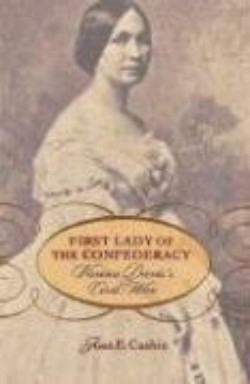First Lady of the Confederacy
Varina Davis's Civil War
Seventeen-year-old Varina Howell had these thoughts about the thirty-five-year-old widower she met in December, 1843: “He has a way of taking for granted that everybody agrees with him when he expresses an opinion, which offends me; yet he is most agreeable and has a peculiarly sweet voice and a winning manner of asserting himself.” Fourteen months later she would marry the man, up-and-coming politician Jefferson Davis.
The author, a professor of history at Ohio State University specializing in the social history of the Antebellum, Civil War, and Reconstruction eras, has written what’s being called the first definitive biography of Varina Howell Davis.
Davis’s story tracks along with the nation’s history as Cashin traces her family’s early roots in the northeast, especially New Jersey, where her grandfather was governor for four terms. After his own military career, her father settled in Natchez, Mississippi, where Varina was born in 1826.
Very well educated for the time, Varina corresponded prolifically throughout her life with her Northern cousins, her mother, and the many friends she acquired in Washington, D.C., in the 1850s—some of the happiest times of her life—when Jefferson served as a senator and in Franklin Pierce’s cabinet. Cashin combed through these letters to give voice to Varina’s thoughts.
It’s the voice of a woman trying to survive the tumultuousness of the times; because she was Davis’s wife, she became the First Lady of the Confederacy when the Southern states withdrew from the Union. Internally conflicted, she publicly supported her husband and the South during the war, but remained a controversial figure for the nearly forty years after its conclusion until her death.
She became feistier with age; first as an expatriate; then, after her husband’s death, as a writer living in New York City. Criticized deeply by the South for this move among many other purported “indiscretions”), she told her daughter she was “free, brown, and sixty-four.” This sardonic reference to her olive complexion, suggests that she did not accept the Confederate view of her appearance, after having long endured whispered comments.
Although it’s easy for readers to follow the flow of events leading up to and following the Civil War as they pertained to Varina, an abbreviated time-line of significant dates births and deaths of immediate family members, etc.) might have been of use to some readers. Sadly, she outlived all but one of her children.)
“With friends she occasionally reflected on her life, which had been ‘checkered,’ she said, with some ‘stirring’ times, which was something of an understatement.” Varina died in 1906 at age eighty. This book is a portrait of a strong, remarkable—and for the times, modern—woman.
Reviewed by
Robin Farrell Edmunds
Disclosure: This article is not an endorsement, but a review. The publisher of this book provided free copies of the book to have their book reviewed by a professional reviewer. No fee was paid by the publisher for this review. Foreword Reviews only recommends books that we love. Foreword Magazine, Inc. is disclosing this in accordance with the Federal Trade Commission’s 16 CFR, Part 255.

